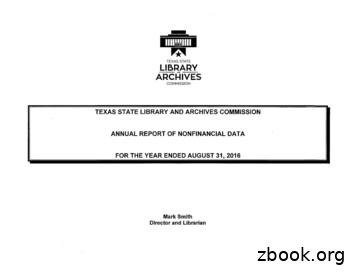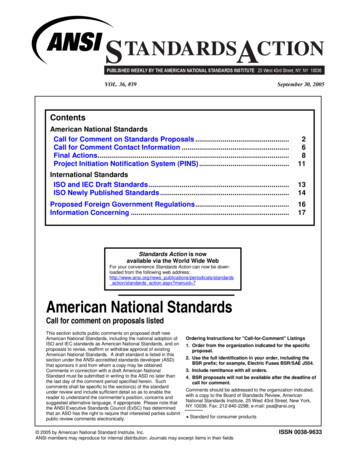AWS Migration Hub
AWS Migration HubUser Guide
AWS Migration Hub User GuideAWS Migration Hub: User GuideCopyright Amazon Web Services, Inc. and/or its affiliates. All rights reserved.Amazon's trademarks and trade dress may not be used in connection with any product or service that is notAmazon's, in any manner that is likely to cause confusion among customers, or in any manner that disparages ordiscredits Amazon. All other trademarks not owned by Amazon are the property of their respective owners, who mayor may not be affiliated with, connected to, or sponsored by Amazon.
AWS Migration Hub User GuideTable of ContentsWhat Is AWS Migration Hub? . 1Are You a First-Time User of AWS Migration Hub? . 1Setting Up . 2Sign Up for AWS . 2Create an IAM User . 2Getting Started . 4Assumptions . 4Access to AWS Migration Hub . 5Two Ways to Get Started . 5Perform Discovery and Then Migrate . 6Migrate Without Performing Discovery . 8Walkthroughs . 11Perform Discovery and Then Migrate . 11Phase 1: Discover . 12Phase 2: Migrate . 17Phase 3: Track . 18Migrate Without Performing Discovery . 19Phase 1: Migrate . 20Phase 2: Track . 22Doing More in Migration Hub . 23Tracking Migration Updates . 23Tracking When You Perform Discovery First and Then Migrate . 23Tracking When You Migrate Without Performing Discovery . 24Troubleshooting and Manually Mapping Migration Updates . 24Tracking Metrics Using the Dashboards . 24Main Dashboard . 24Navigating from the Dashboard and the Navigation Pane . 25Tagging Migration Resources . 26Home Region . 27Choose a Migration Hub Home Region . 27Set a Home Region for Discovery . 27Set a Home Region for Migration Reporting . 28Changing Your Migration Hub Home Region . 28Working with the Migration Hub Home Region APIs . 28Amazon EC2 Recommendations . 30Prerequisites . 30How EC2 Instance Recommendations Work . 30Generating Amazon EC2 Recommendations . 31Understanding Your Amazon EC2 Recommendations . 32Additional Considerations . 36Viewing Network Connections . 38Use the Network Diagram to View Connections . 38Prerequisites . 38How to use the Network Diagram . 39Toolbar . 40Diagram . 40Server Details and Selected Server List . 42Troubleshooting . 43Message that You Need to Install Discovery Agent . 43Problems When Adding Servers or Expanding Diagram . 43Security . 45Identity and Access Management . 45Authentication . 45Access Control . 46iii
AWS Migration Hub User GuideMigration Hub Roles & Policies . 47Migration Hub API Permissions Reference . 50Authentication & Access Explained . 53Using Service-Linked Roles . 58Logging and monitoring in AWS Migration Hub . 64Quotas . 65Troubleshooting . 66Migrations not appearing in AWS Migration Hub . 66Authentication . 66Migration status matching . 66Migrations not appearing in application . 66Servers' Application Grouping . 67Check Update Status . 67Check Update/Server mapping . 67API Call Failed . 67Errors Enabling Data Collection . 67AWS Migration Hub API . 68Reporting Migration Status Updates . 68Creating a ProgressUpdateStream for your Migration Tool . 68Importing a Migration Task . 68Associating a Migration Task with a Previously Discovered Server . 68Auto-Mapping Explained . 69Sending Migration Status Updates . 69Migration Tool Expected Behavior . 69API Endpoints . 70API Version . 70AWS CloudTrail . 70Related Topics . 70Actions . 71AssociateCreatedArtifact . 72AssociateDiscoveredResource . 75CreateProgressUpdateStream . 78DeleteProgressUpdateStream . 81DescribeApplicationState . 84DescribeMigrationTask . 87DisassociateCreatedArtifact . 90DisassociateDiscoveredResource . 93ImportMigrationTask . 96ListApplicationStates . 99ListCreatedArtifacts . 102ListDiscoveredResources . 106ListMigrationTasks . 110ListProgressUpdateStreams . 114NotifyApplicationState . 117NotifyMigrationTaskState . 120PutResourceAttributes . 124Data Types . 127ApplicationState . 128CreatedArtifact . 129DiscoveredResource . 130MigrationTask . 131MigrationTaskSummary . 133ProgressUpdateStreamSummary . 135ResourceAttribute . 136Task . 138Logging Migration Hub API Calls with AWS CloudTrail . 139Migration Hub Information in CloudTrail . 139iv
AWS Migration Hub User GuideUnderstanding Migration Hub Log File Entries . 140Document History . 141v
AWS Migration Hub User GuideAre You a First-Time User of AWS Migration Hub?What Is AWS Migration Hub?AWS Migration Hub (Migration Hub) provides a single place to discover your existing servers, planmigrations, and track the status of each application migration. The Migration Hub provides visibilityinto your application portfolio and streamlines planning and tracking. You can visualize the connectionsand the status of the servers and databases that make up each of the applications you are migrating,regardless of which migration tool you are using.Migration Hub gives you the choice to start migrating right away and group servers while migration isunderway, or to first discover servers and then group them into applications. Either way, you can migrateeach server in an application and track progress from each tool in the AWS Migration Hub.Migration Hub supports migration status updates from the following AWS services: AWS Database Migration Service AWS Server Migration Service CloudEndure MigrationMigration Hub also supports migration status updates from the ATADATA ATAmotion partner tool.For more information, open the AWS Migration Hub console at https://console.aws.amazon.com/migrationhub/, and in the navigation pane under Migrate, choose Tools. Note that you must first have anAWS account and credentials for access to the Migration Hub console - see Setting Up (p. 2).Are You a First-Time User of AWS Migration Hub?On your first use of the AWS Migration Hub console, you’ll be prompted to select a Migration Hubhome region where your data will be stored. You can choose a home region on the Settings page of theconsole. After you select a home region, you are redirected automatically to the console in that AWSRegion. You must make a selection before you can perform any write action from the console, SDK, orCLI interfaces.If you are a first-time user of AWS Migration Hub, we recommend that you read the following sections inorder: Getting Started (p. 4) Home Region (p. 27) Walkthroughs (p. 11)To learn about sending status to or querying status from AWS Migration Hub using the AWS SDK or AWSCLI, see: AWS Migration Hub API (p. 68) AWS Migration Hub Home Region APIRemember that only your migration tracking data is stored in your home region. You can migrate intoany AWS Region supported by your migration tool.If you have a tool that you want to integrate with AWS Migration Hub, contact us by choosing Feedbackin the lower left-hand corner of the footer in the AWS Migration Hub console. For all support issues,contact us here.1
AWS Migration Hub User GuideSign Up for AWSSetting UpBefore you use AWS Migration Hub for the first time, if you have not done so, complete the followingtasks:1. Sign Up for AWS (p. 2)2. Create an IAM User (p. 2)Sign Up for AWSWhen you sign up for Amazon Web Services (AWS), you are charged only for the services that you use. Ifyou already have an AWS account, you can skip this step.If you have an AWS account already, skip to the next task. If you don't have an AWS account, use thefollowing procedure to create one.To create an AWS account1.Open low the online instructions.Part of the sign-up procedure involves receiving a phone call and entering a verification code on thephone keypad.Note your AWS account number, because you'll need it for the next task.Create an IAM UserServices in AWS, such as AWS Migration Hub, require that you provide credentials when you accessthem, so that the service can determine whether you have permissions to access its resources. AWSrecommends that you do not use the root credentials of your AWS account to make requests. Instead,create an IAM user, and grant that user full access. We refer to these users as administrator users. Youcan use the administrator user credentials, instead of root credentials of your account, to interact withAWS and perform tasks, such as create a bucket, create users, and grant them permissions. For moreinformation, see Root Account Credentials vs. IAM User Credentials in the AWS General Reference and IAMBest Practices in the IAM User Guide.If you signed up for AWS but have not created an IAM user for yourself, you can create one using the IAMconsole.To create an administrator user for yourself and add the user to an administrators group(console)1.Sign in to the IAM console as the account owner by choosing Root user and entering your AWSaccount email address. On the next page, enter your password.NoteWe strongly recommend that you adhere to the best practice of using the AdministratorIAM user that follows and securely lock away the root user credentials. Sign in as the rootuser only to p
AWS Migration Hub API (p. 68) AWS Migration Hub Home Region API Remember that only your migration tracking data is stored in your home region. You can migrate into any AWS Region supported by your migration tool. If you have a tool that you want to integrate with AWS
4 AWS Training & Services AWS Essentials Training AWS Cloud Practitioner Essentials (CP-ESS) AWS Technical Essentials (AWSE) AWS Business Essentials (AWSBE) AWS Security Essentials (SEC-ESS) AWS System Architecture Training Architecting on AWS (AWSA) Advanced Architecting on AWS (AWSAA) Architecting on AWS - Accelerator (ARCH-AX) AWS Development Training
AWS Directory Amazon Aurora R5 instance Service AWS Server Migration Service AWS Snowball AWS Deep Amazon GameLift Learning AMIs AWS CodeBuild AWS CodeDeploy AWS Database Migration Service Amazon Polly 26 26 20 40 12 0 5 10 15 20 25 30 35 40 45 2018 Q1 2018 Q2 2018 Q3 2018 Q4 2019 Q1 New Services& Features on AWS
AWS SDK for JavaScript AWS SDK for JavaScript code examples AWS SDK for .NET AWS SDK for .NET code examples AWS SDK for PHP AWS SDK for PHP code examples AWS SDK for Python (Boto3) AWS SDK for Python (Boto3) code examples AWS SDK for Ruby AWS SDK for Ruby co
AWS instances with Nessus while in development and operations, before publishing to AWS users. Tenable Network Security offers two products on the AWS environment: Nessus for AWS is a Nessus Enterprise instance already available in the AWS Marketplace. Tenable Nessus for AWS provides pre-authorized scanning in the AWS cloud via AWS instance ID.
ambonare inc hub as 18,700.00 ambonare inc hub as 373,223.00 amtex scale & system hub wo 250.00 austin ribbon & comp hub wo 422.60 ava consulting hub as 175,658.31 flores and associate hub hi 62.00 hydrozone landscape hub hi 5,145.00 ibridge group inc hub wo 540.00 language usa inc hub wo 254.80 precision micrograph hub wo 17,837.88
BSR/AWS B5.16-200x, Specification for the Qualification of Welding Engineers (revision of ANSI/AWS B5.16-2001) Obtain an electronic copy from: roneill@aws.org Order from: R. O’Neill, AWS; roneill@aws.org Send comments (with copy to BSR) to: Andrew Davis, AWS; adavis@aws.org; roneill@aws.org Single copy price: 25.00
pa/1g pa/1f pb/2f pc/2g pd/4f 156 pf/3g pf/3f pg/3g pg/3f en: pcfileur welding positions aws: 1g en: pa aws: 1f aws: 2g en: pc aws: 2f en: pb aws: 3g en: pg down en: pf up aws: 3f down en: pf aws: 4g en: pe aws: 4f en: pd 156
Bereavement counseling includes a broad range of transition services including outreach, counseling, and referral services for family members. There is no cost for VA bereavement counseling. More information is available by contacting the Readjustment Counseling Service at 202-461-6530 or online at the . Vet Center website. Army


















